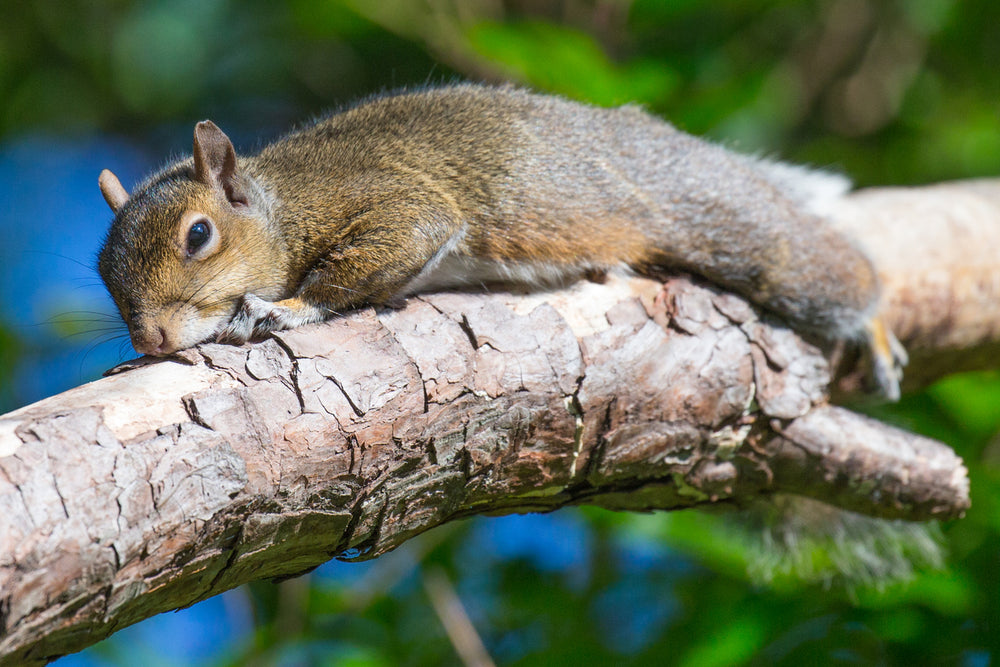Say No to Poisoning Squirrels in Attics & Crawlspaces

Will poisoning and killing squirrels keep the next one from coming into your house?
I don't think so.
Using poison is not an easy solution. It's actually not a solution at all.
Are you prepared to deal with a new set of dangerous and unnecessary consequences?
You should never use poison for squirrels in attics. Squirrels are not so easy to convince with poison. Rodents as a whole are scavengers, and generally “taste” their food to see if suitable for eating.
Poisons with any funny odors or strange flavors have a high probability of being discarded by the squirrel.
Let's assume...the squirrel does decide that the poisoned food source is desirable. Now what?
Keep in mind that squirrels store their food for later use, especially in colder seasons.
This means you may have to wait some time before the proper dosage is ingested by the squirrel or squirrels.
What about odorless, tasteless poisons? Those do exist, and they are also dangerous to everyone.
Why does this matter?
Rodenticides fall in any of these chemical categories:
Anticoagulants—SLOW DEATH (1-2wks).
These poisons will disrupt the “Vitamin K cycle” in the rodent.
The Vitamin K cycle is essential for specific proteins to form blood clots.
Anticoagulants will cause damage to the blood vessels, resulting in hemorrhaging.
This exhausts the animal in weakness and stops the animal's ability to heal.
The liver, an organ essential for detoxing the body, is disabled of its functions.
The animal ultimately collapses of hypovolemic circuiatory shock and internal hemorrhaging of the entire body.



Metal Phosphides—Fast Death (1-3 days).
Zinc phosphide is the most common compound used in this category.
Once eaten, a chemical reaction between the acids in the rodent’s stomach and the phosphides create phosphine gas.
Because rodents naturally lack the ability of a gag-reflex, once the bait is eaten it is eventually processed.
This highly toxic gas ultimately enters the bloodstream, causing damage to the blood vessels and decreased amounts of oxygen to all major organs.
The animal suffers from loss of coordination, convulsions, paralysis, brain damage, capillary breakdown and again ending in cardiovascular collapse.



Cholecalciferol—Death Varied (1-7 days).
This category involves the use of Vitamin D. We know Vitamin D as a great benefit to our systems. However, when taken in lethal quantities, it will cause hypercalcemia.
Hypercalcemia involves dangerously high calcium levels in the bloodstream.
When large quantities are ingested, the absorbed calcium levels will cause severe damage to the stomach wall, lungs, kidneys, and blood vessels.
These tissues and organs will deteriorate due to calcium crystal formations, and ultimately the heart and kidneys will fail, and the animal will have internal bleeding.
Go back and read the red...only this time imagine a child or a pet coming into contact with one of these poisons.
Once you understand how these poisons affect an animal, it’s easier to see why this is inhumane.
Not convinced?? Consider the following questions:
Do you have any pets?
If you were to use poison to get rid of your "pests", please realize that you are putting your pets in danger as well.
Cats and dogs may touch or ingest the poisonous bait or they could end up finding the poisoned, dead animal.
Cats are the most susceptible to endangering their health because they are more agile and able to get into these hard to reach places.
In 2016, the ASPCA Animal Poison Control Center (APCC) released an infographic showing a map of the United States.
Each state shows the #1 pet toxin reported in that state.
"Rat Poison" (aka Rodenticide) is listed far too many times across the US.
In trying to rid your home of pests, you risk inflicting the same excruciating pain and horrible damage on your pets.
Even if you don't have any pets...
Would you be ok knowing you're placing a neighbor's pet in danger?
Do you have any children?
Obviously, if pets can be harmed by poison, then small children could be too, right?
But how often do children really come into contact with poison?
In 2010, Scientific American® published a startling health report. To quote this 2-part article:
"Every year more than 10,000 kids are getting a hold of them, and virtually all of the calls to the US poison control centers concern children under six."
Ten-Thousand Children?! All under six years of age being poisoned every year by rodenticides.
The article goes on to say that the EPA estimates that the "incidents reported poison-control centers probably accounted for only about one-fourth of all exposures".
The EPA has made modifications to rodenticide standards and what is available to residential consumers vs. pest professionals. As of 2017, rodenticide in pellet form have officially been banned in the U.S.
Regardless of its form, the main purpose of a rodenticide is to poison.
Rodenticides kill.
Whether you're looking for the most humane pest control solution, or you simply want to keep your family safe and your home pest-free, keep in mind that there are ways to solve your squirrel problem without imparting harm to anyone, and with lasting effects.




Leave a comment
Also in Articles
How to Get Rid of Squirrels in the Attic
By Ryan Earl August 13, 2023 2 Comments
Continue reading
The Best Way to Eliminate Squirrels in Attics, Crawlspaces, Basements, Garages, Cars & More
By Ryan Earl February 23, 2018 4 Comments
Continue reading
Deb Welter of Diamond Rock Wildlife Rehabilition Clinic trusts the Evictor®
By Ryan Earl February 08, 2018
Continue reading